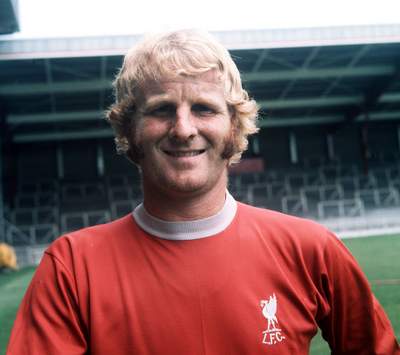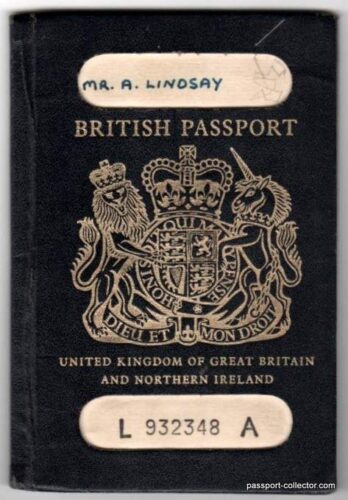The passport of a Liverpool football player
It is always a joy to get reader-emails, especially when they include pictures of unusual passports. Here comes such a document from a British gentleman who wanted to have an expert opinion on one of the Liverpool football players’ passports. He is willing to depart from this for English football fans quite interesting document. But let’s have a look at the details first. Liverpool football player
The British passport was issued on 9 March 1978 at the Liverpool passport office to Alec Lindsay from Bury. As you can see in the pictures, the condition is excellent and with no corner clips or other signs of invalidation of the travel document. His three-year-old son Alec J.C. is included in the passport but without a picture. Usually, children are rather included in the wife’s passport. Liverpool football player
 Alec Lindsay (born 27 February 1948) is an English former footballer who played in the Football League for Bury, Liverpool, and Stoke City. Born in Bury, Lancashire, England, Lindsay played 139 matches for Bury, helping the club gain promotion in 1967–68. Manager Bill Shankly signed him for Liverpool in March 1969 for £67,000. He made his debut against Irish side Dundalk in the European Fairs Cup on 16 September 1969. After an initial settling in which Lindsay played seven times, he was selected as the first choice left-back during the 1970–71 season, including the 1971 FA Cup Final at Wembley. Liverpool football player
Alec Lindsay (born 27 February 1948) is an English former footballer who played in the Football League for Bury, Liverpool, and Stoke City. Born in Bury, Lancashire, England, Lindsay played 139 matches for Bury, helping the club gain promotion in 1967–68. Manager Bill Shankly signed him for Liverpool in March 1969 for £67,000. He made his debut against Irish side Dundalk in the European Fairs Cup on 16 September 1969. After an initial settling in which Lindsay played seven times, he was selected as the first choice left-back during the 1970–71 season, including the 1971 FA Cup Final at Wembley. Liverpool football player
Liverpool won a double in 1973, winning the League championship and UEFA Cup against Borussia Mönchengladbach. He played in the 1974 FA Cup Final against Newcastle United, and despite him having a goal ruled out for offside, Lindsay got his winners medal as Liverpool beat the Magpies 3–0. Liverpool football player
This was to be the peak of Lindsay’s Liverpool career. Shankly, the man who brought Lindsay to Merseyside, decided to retire in the summer of 1974. Unfortunately for Lindsay, new manager Bob Paisley selected Phil Neal as his regular left-back the following season. Even after Neal moved to his favored right-back role, Lindsay was still rarely selected, Paisley, preferring Welshman Joey Jones. He had already played four times for the England team but was not selected for England again after falling out of favor at Anfield. Liverpool football player
Liverpool won two more League titles during the next three years, but Lindsay did not play enough games on either occasion to collect a league title medal. He also missed out on the 1976 UEFA Cup success and the 1977 FA Cup. He left Anfield in the summer of 1977 and joined Stoke City. He made a good start to his Stoke career, converting three penalties in his first five matches for George Eastham’s club. However, with the Victoria Ground’s expectation to gain an instant return to the First Division, Eastham was sacked in early January 1978, with the club languishing in mid-table. New manager Alan Durban decided to play the younger Geoff Scott at left-back, and Lindsay was allowed to move to America. Liverpool football player

In 1978, Lindsay moved to the Oakland Stompers of the North American Soccer League (NASL). Following the 1978 season, the Stompers moved to Edmonton, Alberta, Canada and Lindsay moved to the Toronto Blizzard and the NASL. He played four times for Toronto Blizzard in 1979 before hanging up his boots at the age of 31. According to the website transfermarket.com, his favorite jersey number with Liverpool was 3. In his career, he played a total of 350 matches and shot 29 goals.

Lindsay is now retired and lives with his partner in Scotland. He remained an avid Liverpool supporter and was a contributor to the Hillsborough Family Support Group’s (HFSG) “Project 96” in August 2009. After his retirement, he became a publican at Foundry Arms in Leigh. Liverpool football player

This passport shows several USA and Canada stamps/visas, clearly stating in handwriting at one US visa “Oakland Stompers For every Liverpool / English Football fan a very nice collectible, which could be yours by contacting the current bearer of the document by email..” Liverpool football player

FAQ Passport History
Passport collection, passport renewal, old passports for sale, vintage passport, emergency passport renewal, same day passport, passport application, pasaporte passeport паспорт 护照 パスポート جواز سفر पासपोर्ट
1. What are the earliest known examples of passports, and how have they evolved?
The word "passport" came up only in the mid 15th Century. Before that, such documents were safe conducts, recommendations or protection letters. On a practical aspect, the earliest passport I have seen was from the mid 16th Century. Read more...
2. Are there any notable historical figures or personalities whose passports are highly sought after by collectors?
Every collector is doing well to define his collection focus, and yes, there are collectors looking for Celebrity passports and travel documents of historical figures like Winston Churchill, Brothers Grimm, Johann Wolfgang von Goethe. Read more...
3. How did passport designs and security features change throughout different periods in history, and what impact did these changes have on forgery prevention?
"Passports" before the 18th Century had a pure functional character. Security features were, in the best case, a watermark and a wax seal. Forgery, back then, was not an issue like it is nowadays. Only from the 1980s on, security features became a thing. A state-of-the-art passport nowadays has dozens of security features - visible and invisible. Some are known only by the security document printer itself. Read more...
4. What are some of the rarest and most valuable historical passports that have ever been sold or auctioned?
Lou Gehrig, Victor Tsoi, Marilyn Monroe, James Joyce, and Albert Einstein when it comes to the most expensive ones. Read more...
5. How do diplomatic passports differ from regular passports, and what makes them significant to collectors?
Such documents were often held by officials in high ranks, like ambassadors, consuls or special envoys. Furthermore, these travel documents are often frequently traveled. Hence, they hold a tapestry of stamps or visas. Partly from unusual places.
6. Can you provide insights into the stories behind specific historical passports that offer unique insights into past travel and migration trends?
A passport tells the story of its bearer and these stories can be everything - surprising, sad, vivid. Isabella Bird and her travels (1831-1904) or Mary Kingsley, a fearless Lady explorer.
7. What role did passports play during significant historical events, such as wartime travel restrictions or international treaties?
During war, a passport could have been a matter of life or death. Especially, when we are looking into WWII and the Holocaust. And yes, during that time, passports and similar documents were often forged to escape and save lives. Example...
8. How has the emergence of digital passports and biometric identification impacted the world of passport collecting?
Current modern passports having now often a sparkling, flashy design. This has mainly two reasons. 1. Improved security and 2. Displaying a countries' heritage, icons, and important figures or achievements. I can fully understand that those modern documents are wanted, especially by younger collectors.
9. Are there any specialized collections of passports, such as those from a specific country, era, or distinguished individuals?
Yes, the University of Western Sidney Library has e.g. a passport collection of the former prime minister Hon Edward Gough Whitlam and his wife Margaret. They are all diplomatic passports and I had the pleasure to apprise them. I hold e.g. a collection of almost all types of the German Empire passports (only 2 types are still missing). Also, my East German passport collection is quite extensive with pretty rare passport types.
10. Where can passport collectors find reliable resources and reputable sellers to expand their collection and learn more about passport history?
A good start is eBay, Delcampe, flea markets, garage or estate sales. The more significant travel documents you probably find at the classic auction houses. Sometimes I also offer documents from my archive/collection. See offers... As you are already here, you surely found a great source on the topic 😉
Other great sources are: Scottish Passports, The Nansen passport, The secret lives of diplomatic couriers
11. Is vintage passport collecting legal? What are the regulations and considerations collectors should know when acquiring historical passports?
First, it's important to stress that each country has its own laws when it comes to passports. Collecting old vintage passports for historical or educational reasons is safe and legal, or at least tolerated. More details on the legal aspects are here...
Does this article spark your curiosity about passport collecting and the history of passports? With this valuable information, you have a good basis to start your own passport collection.
Question? Contact me...

